Randwick is part of the country of Kameygal/Gameygal people.
In 1833, the first horse race was held at Randwick Racecourse. (A race track was first laid out in Randwick using convict labour and called the Sandy Course)
The first
stone house at Randwick was built in 1848, called Blenheim House, which still exists.
Hooper Cottage at 17 Gilderthorpe Avenue, Randwick, was also built around 1848. It also survives and is still in good condition.
Randwick was Sydney's first municipality outside the CBD in 1859. In the same year, Coogee Bay Road was
constructed between Carrington Road and Coogee Beach.
An asylum for Destitute Children was built at Randwick in 1858 to house 400 children on 60 acres. A new wing was built in 1863 for 400 more children.
 |
| The oldest house in Randwick, NSW, Australian Town and Country Journal (Sydney, NSW : 1870 - 1919), Saturday 29 September 1900 |
 |
GATHERING OF THE CARS IN FRONT OF THE INSTITUTION FOR A HOLIDAY EXCURSION. RANDWJCK ASYLUM, SYDNEY. FOR THE RELIEF 0F- DESTITUTE CHILDREN. Australasian (Melbourne, Vic. : 1864 - 1946), Saturday 21 December 1907 |
 |
| The old council chambers at Randwick, NSW, built in 1866, Daily Telegraph (Sydney, NSW : 1883 - 1930) |
 |
| Allison Road, Randwick, NSW, in the 1870s. SLNSW |
In 1880, Randwick Tramway Workshop was established.
Randwick District Rugby Union Football Club was established in 1882.
 |
| Derby Day, Randwick, NSW, Australasian (Melbourne, Vic. : 1864 - 1946), Saturday 21 September 1895 |
 |
| Grand Stand, Randwick, NSW, Punch (Melbourne, Vic. : 1900 - 1918; 1925), Thursday 17 September 1903 |
The Randwick Theatre
opened in 1921 and donated the opening night takings to the Eastern Suburbs District Ambulance Service.
The Ritz Theatre on Saint Pauls Street in Randwick, built in the Art Deco style, opened in 1937.
The Ritz was designed by Aaron Bolot, the same architect who designed other Art Deco buildings in Potts Point. This theatre was nearly demolished in 1993 until interventions by the Randwick Council saved it. The building is now protected by a Permanent Heritage Order.
Around Randwick and The Randwick Ritz
 |
| The Randwick Ritz, Randwick, NSW |
 |
| Randwick Ritz, Randwick, NSW |
 |
| Randwick Ritz, Randwick, NSW |
 |
| Hooper Cottage at 17 Gilderthorpe Avenue, Randwick was built around 1848. |
 |
| Hooper Cottage at 17 Gilderthorpe Avenue, Randwick was built around 1848. |
 |
| The Spot is located in the south-eastern part of the suburb of Randwick, NSW, around the intersection of Perouse Road and St Pauls Street |
 |
| The Spot is located in the south-eastern part of the suburb of Randwick, NSW, around the intersection of Perouse Road and St Pauls Street |
 |
| Superintendent's Cottage, Prince of Wales Hospital, built (The Prince of Wales Hospital was initially part of the Randwick Asylum for Destitute Children, which was established on its current High Street Randwick site in 1858) |
 |
| Randwick Town Hall, NSW, opened, 3rd February 1882 |
 |
| Corana and Hygeia, also known as Randwick Lodge, Avoca Street, Randwick, NSW. They were built from 1893 to 1894. |
 |
| Tayar, The Avenue, Randwixk, NSW, a two-storey Victorian Italianate house built in c1900 |
 |
| St Jude's Church, Avoca Street, Randwick, NSW ( built 1865 to design inspired by St John's Church, Randwick, Gloucestershire, England) |
 |
| Venice is a heritage-listed apartment building and residence in Randwick, City of Randwick, NSW, built from 1884 to 1885 by Stephen Gee. |
 |
| Former Randwick Post Office, NSW, built in 1898 is Federation Freestyle |
 |
| "Aston Lodge" was built for John Watkins in 1865. Randwick, NSW. Now a private school, the Emanuel School |
 |
| Ventnor Avoca Street, Randwick Built 1858 by Edward Dawson. Bought c. 1876 by George Kiss, auctioneer of Kiss' Horse Bazaar, George Street, Sydney. Mayor of Randwick 1878. Family resided there until 1963 when sold to Our Lady of the Sacred Heart Church. |
Places To Go
The Ritz Cinema, also known as the Ritz Theatre, is a heritage-listed cinema located at 43 St Pauls Street, in the Sydney suburb of Randwick, NSW
The La Perouse Museum is located at 1542 Anzac Parade, La Perouse, NSW






























